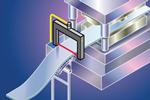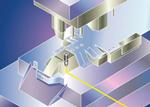Sensor-based Error Proofing Specialist
- FMA
- The Fabricator
- FABTECH
- Canadian Metalworking
Categories
- Additive Manufacturing
- Aluminum Welding
- Arc Welding
- Assembly and Joining
- Automation and Robotics
- Bending and Forming
- Consumables
- Cutting and Weld Prep
- Electric Vehicles
- En Español
- Finishing
- Hydroforming
- Laser Cutting
- Laser Welding
- Machining
- Manufacturing Software
- Materials Handling
- Metals/Materials
- Oxyfuel Cutting
- Plasma Cutting
- Power Tools
- Punching and Other Holemaking
- Roll Forming
- Safety
- Sawing
- Shearing
- Shop Management
- Testing and Measuring
- Tube and Pipe Fabrication
- Tube and Pipe Production
- Waterjet Cutting
Industry Directory
Webcasts
Podcasts
FAB 40
Advertise
Subscribe
Account Login
Search
Where sensors make sense
Errorproofing your stamping process
- By Dave Bird
- April 15, 2008
- Article
- Bending and Forming

Sensor-driven errorproofing can help stamping shops prevent the production of bad parts, die crashes, and downtime.
Metal formers today find that increasingly customers are no longer satisfied with just a low percentage of defective parts, measured in parts per thousand. Today customers insist on getting no bad parts at all.
Sensor-driven errorproofing can help metal stamping shops prevent the production of bad parts. In addition, it can save tens of thousands of dollars in lost production caused by crashed dies and downtime. How? Sensors detect the presence of metal—as material being fed into the press, being positioned, or ejected from the press as a stamped part or slug.
Stampers can prevent most die crashes and defective parts production if they know where the use of sensors is essential.
Essential Sensing—Feed-in, Part-out
Ninety percent of all die protection and parts quality problems revolve around two basic functions: material progression and parts-out. To protect the die and the press, as well as to produce high-quality parts, stampers need to monitor carefully three areas:
- Feed-in. To confirm that the metal—especially the end of the strip—is progressing correctly into and through the die, whether by roll feed or sheet feed.
- Material Progression. To ensure that the stripper is functioning and material is progressing properly (when using progressive dies), or to make sure that the sheet is nesting correctly in the die (when using transfer dies).
- Part, Slug Ejection. To detect foreign objects, such as slugs or parts that have not been ejected, before they can damage the die, press, and material.
Prevent Incorrect Feed
In all automated presses, material must enter the press in a specific, measurable way.
Fork Sensor. A fork through-beam laser sensor can indicate correct or incorrect guiding as it checks for buckling and progression of the feedstock. If the sensor detects incorrect guiding, it triggers the feed to stop instantly to prevent press or sheet damage (see Figure 1).
Monitor Sheet Thickness
Output Sensor. Highly accurate, robust analog output inductive sensors monitor the thickness of material as it is fed into a stamping press (seeFigure 2). In roll feeds, they are set up in opposition to the sheet metal moving in between. Output parameters from the sensors correlate to the desired material thickness, and a deviation from these parameters indicates a change in material thickness or the presence of a double blank. When a sensor detects a deviation, it causes the feed to stop instantly.
While the perfect double-blank detection method has yet to be discovered, these techniques go a long way toward preventing double blanking and misfeeds.
Detect Pilot Hole Positioning
Proximity Sensor. A hole in the part being stamped can be used to ensure that there is proper material feed, positive strip placement, and a correctly synchronized die process. An inductive proximity sensor monitors lead and trail pilot holes to verify that the guide pin is correctly engaging them (see Figure 3). Thus, it can confirm correct punch hole positioning in a progressive die as the part being stamped nears its final configuration.
Detect Slug-Out
Proximity Sensor. To prevent expensive die damage and "fossil imprints" on finished parts, all slugs need to be successfully ejected before the next part is stamped. Inductive proximity sensors also detect the presence or absence of slugs, verifying whether they have been ejected.
In Figure 4, a tubular inductive proximity sensor detects full punch retraction, while a self-contained through-beam fork sensor and a larger inductive proximity flatpack sensor verify successful slug ejection, or slug-out.
Self-contained, L-shaped through-beam sensors can monitor slug-out applications without interfering with the die process. L-shaped, or angle, sensors shoot a beam from corner to corner and allow for greater placement flexibility where self-contained fork through-beam sensors cannot be used. Figure 5shows an L-shaped through-beam sensor verifying the final configuration of a part after slugs have been ejected.
Detect Part-Out
Optical Window Sensor. Dynamic optical window sensors provide a unique, on-the-fly verification of parts ejection from stamping dies, even when the parts eject at high speeds or at random orientations and trajectories. Stationary opaque or clear tubes or funnels can be installed within the sensor for forced directional aiming of finished parts (see Figure 6).
Photoelectric Sensor. Photoelectric sensors verify part ejection through diffuse-reflective, retro-reflective, and through-beam energized pairs in infared, visible red, or laser emissions (see Figure 7).
Bar Sensor. Bar sensors are rectangular, long-range inductive sensors that are suitable for many metallic parts-out sensing applications. Some models have adjustable sensing ranges, while others have a fixed range, giving stampers options for verifying ejection of both small and large metal formed components (seeFigure 8).
Surviving the Initial Hurdles
- First, the conditions that may lead to stamping program failure must be eliminated. The goal is to end up with a process that stops the die only if parts are defective or the die is in danger.
- The entire organization must be in agreement that a sensor program is necessary. A comparison of the expenses that will be incurred with and without a sensing program can help (see Weighing the Costs of Sensor-driven Errorproofing Against the Costs Without It sidebar). Buy-in from the operators is essential and often overlooked. The team must understand how the sensors can improve part quality or they will tend to ignore steps that they don’t agree with or understand.
- Implementation must be incremental. You can’t eat the elephant in one bite. It is best to start with just one die set until the process works correctly from the beginning and so that the process is understood and supported by all throughout the initial learning curve.
- A choice between retrofitting old dies with embedded sensors or designing a new sensor-integrated die has to be made. It must be determined whether the first project is with a die or a press. If a die will be online in a few months, retrofitting the die might be most efficient; conversely, if a die is going offline, then working with that die may be best.
- Defining the control system that receives the information from the sensors is a critical part of the process. Does the shop have the right control package for a die protection program? How many inputs does it need now and in the future as it expands a die protection program?
- A mechanical person in the organization with toolroom experience perhaps should be enlisted to install sensors on dies.
- Finally, a set of up-to-date bedrock technical die standards must be developed and adhered to.
To read more about the use of sensors in stamping operations, read "Sensors clear the way for high-speed stamping: Safely navigating the press autobahn".
About the Author
Dave Bird
Metals Fabrication Process Improvement
1061 Colina Drive
Villa Hills, KY 41017
513-207-5681
subscribe now

The Fabricator is North America's leading magazine for the metal forming and fabricating industry. The magazine delivers the news, technical articles, and case histories that enable fabricators to do their jobs more efficiently. The Fabricator has served the industry since 1970.
start your free subscription- Stay connected from anywhere

Easily access valuable industry resources now with full access to the digital edition of The Fabricator.

Easily access valuable industry resources now with full access to the digital edition of The Welder.

Easily access valuable industry resources now with full access to the digital edition of The Tube and Pipe Journal.
- Podcasting
- Podcast:
- The Fabricator Podcast
- Published:
- 04/16/2024
- Running Time:
- 63:29
In this episode of The Fabricator Podcast, Caleb Chamberlain, co-founder and CEO of OSH Cut, discusses his company’s...
- Trending Articles
AI, machine learning, and the future of metal fabrication

Employee ownership: The best way to ensure engagement

Steel industry reacts to Nucor’s new weekly published HRC price

Dynamic Metal blossoms with each passing year

Metal fabrication management: A guide for new supervisors

- Industry Events
16th Annual Safety Conference
- April 30 - May 1, 2024
- Elgin,
Pipe and Tube Conference
- May 21 - 22, 2024
- Omaha, NE
World-Class Roll Forming Workshop
- June 5 - 6, 2024
- Louisville, KY
Advanced Laser Application Workshop
- June 25 - 27, 2024
- Novi, MI




























